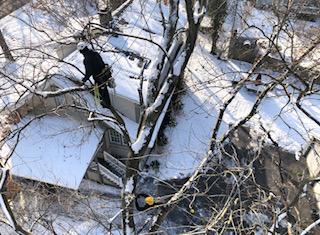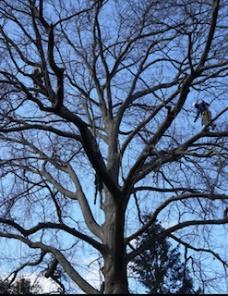Can Pruning Be Done in the Winter?
Of course it can! It’s a common misconception that trees should never be pruned in the winter when, in fact, dormant tree pruning is essential in sustaining your trees’ health, vigor, and vitality. Late Fall through Early Spring is the BEST time to prune trees. Oak Tree especially need to be pruned before the end of March.
Some Benefits to Pruning Your Trees in the Winter Include:
- Reduces the risk of spreading fungal diseases like Dutch Elm, Oak Wilt, and Hypoxylon Canker
- Prepares trees for a healthier and robust Spring
- Price
Easy to Evaluate the Structure
In the winter months, your deciduous trees will lose all of their leaves and this makes all the limbs and the structural integrity of the trees easy to evaluate. Evergreens don’t lose their leaves or greenery in the same manner, but if you have a mixture of both types of trees, your evergreens may lose some needles or leaves from winter weather and storms. On your deciduous trees, it’s much easier for a trained professional to identify any dead limbs that need to be pruned. They can also identify any dangerous branches that may fall on a person or a structure when they are weighed down by thick ice or snow. This benefit is to keep your trees safe.
Spring Has Sprung
When you have your trees pruned in late winter, it allows you to contain them in the space that is dedicated for them. It will also rejuvenate any overgrown shrubs and trees so they will be able to recover very quickly in the spring with new and healthy growth. This is commonly called rejuvenation pruning to jump-start your trees to looking their best in early spring.
Avoiding the Spread of Disease
Most tree diseases are active and spread very easily during the spring and summer growing seasons. Common tree diseases are oak wilt, cedar hawthorn rust, fire blight and Dutch elm disease. When you prune your trees in winter, the diseases are most likely dormant to enable you to rid your trees of it without it spreading to other trees or shrubs in the area because the fungi, parasites, insects and bacteria that spread or cause disease are dead or dormant in the winter.
Frozen Ground is Efficient and Tidy
If you have very large trees that need pruning, it is helpful to do so in the winter when the ground is frozen. Large and heavy equipment can travel over your landscape easily when the ground is frozen. This helps to reduce any damages to your landscape, has faster and better outcomes and can result in lower costs due to the efficiency factor. This is also true when doing tree removal in the winter.
Trees Don't Stress Out
Pruning trees in the winter dormancy period does not stimulate new growth that the cold weather can kill while damaging and disfiguring your trees as fall pruning can when done too late in the year. Every pruning cut leaves a “wound” that is susceptible to destruction by insects and pathogens. This is less likely to be the case when you prune your trees in the winter because it leads to optimum wound closure so they can heal before the warmer weather is upon you.
Preventing Winter Damage
Trees that are damaged, dead or dying can be very dangerous in the winter, especially if we get large amounts of ice or snow. Winter pruning while dormant makes them safer and helps to rejuvenate your weaker trees when dead and diseased wood is removed.
Encouraging Good Growth
Many different types of trees sprout shoots or suckers that will only take the nutrients away from the entire tree and could impact its health. Proper pruning techniques done in the winter can nip these before they grown out of control and it will promote healthy new growth in the spring.
Pruned Trees Live Longer Lives
Pruning a tree actually makes it much stronger and allows them to withstand storms, ice and snow as well as high winds in the winter associated with the weather. Winter pruning also improves the air circulation for your trees as it keeps many diseases from striking and possibly spreading.
Quick Compartmentalization
Trees are not said to “heal” from pruning wounds, but they compartmentalize by walling off decay. When you prune your trees in the winter months, the growth cycle will use less energy to compartmentalize than if your trees were pruned in an active growth cycle in the spring and summer.
If you haven’t pruned your trees in quite some time, the best time to do so is in the winter. They can be evaluated and any corrections that need to be made can be done at the optimum time for your trees health.
Contact us and mention this article to get 20% off of your pruning costs.















